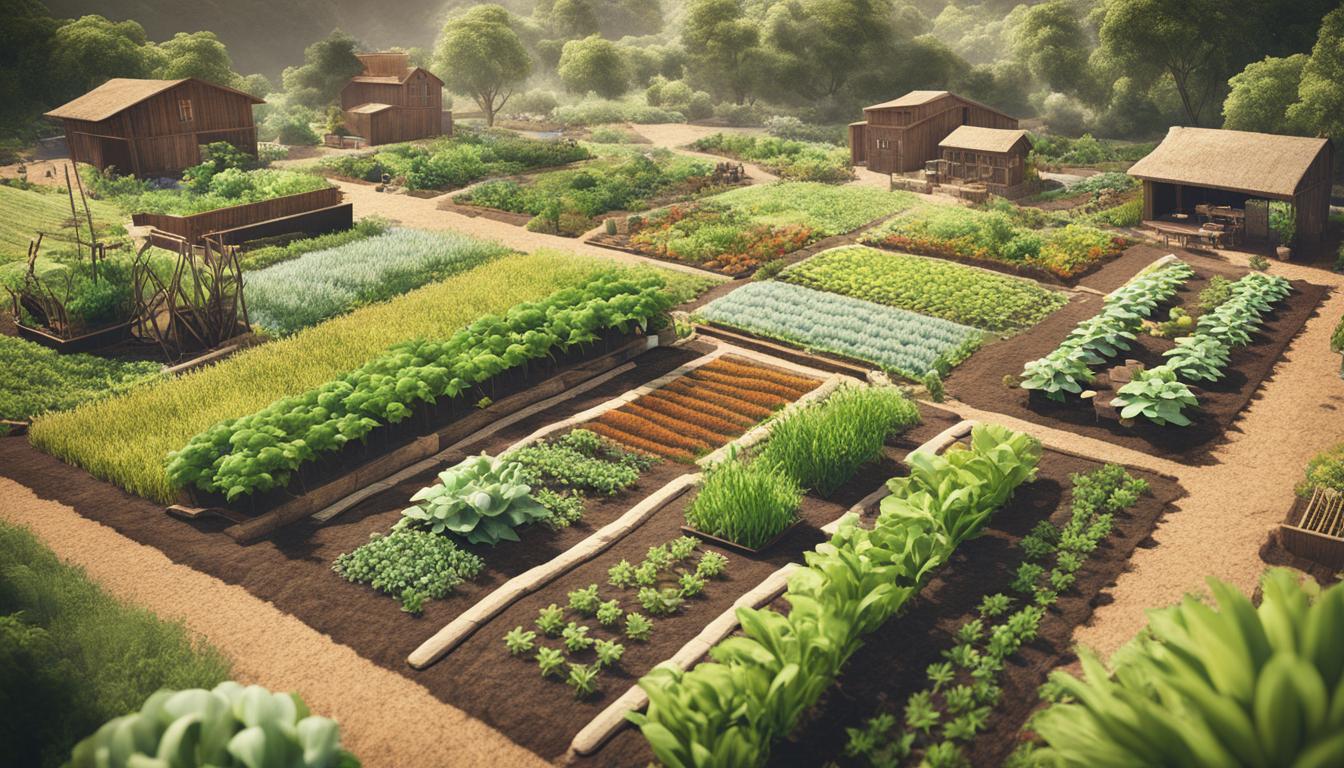Permaculture design principles offer a sustainable approach to agriculture and human habitation, promoting the development of resilient ecosystems and food resilience. By integrating ecological principles and holistic thinking, permaculture provides a framework for creating efficient and harmonious systems that work in harmony with nature.
Key Takeaways:
- Permaculture design principles can be applied to any location, climate, and culture.
- Permaculture encompasses various disciplines such as ecology, landscape design, and energy conservation.
- By mimicking the patterns and relationships found in nature, permaculture systems promote sustainability and biodiversity.
- Permaculture ethics guide the application of design principles and promote personal responsibility and resilience.
- Permaculture aligns closely with regenerative agriculture and sustainable food production practices.
Understanding the Permaculture Design Principles
The Permaculture design principles are essential for creating sustainable and efficient systems that integrate harmoniously with nature. These principles are rooted in sound scientific principles and emphasize whole systems thinking, considering the interconnectedness of elements and their environmental impact.
Each principle represents a conceptual framework for designing dynamic, living systems that mimic the patterns and relationships found in nature. By applying these principles, we can create functional and resilient ecosystems that promote biodiversity and enhance resource efficiency.
The design principles of permaculture highlight several key concepts:
- Relative Location: Understanding the relationship between different elements within a system, such as plants, animals, and structures, to optimize their functionality and efficiency.
- Multiple Functions for Each Element: Designing elements within a system to serve multiple purposes, maximizing their usefulness and minimizing waste.
- Efficient Energy Planning: Considering the energy inputs and outputs of a system, and implementing strategies to reduce energy consumption and maximize renewable energy sources.
- Use of Biological Resources: Utilizing natural processes, such as nutrient cycling and natural pest control, to minimize the use of synthetic inputs and promote ecological balance.
- Small-Scale Intensive Systems: Focusing on small-scale, localized systems to maximize efficiency and productivity while minimizing environmental impact.
- Accelerating Succession and Evolution: Designing systems that encourage natural ecological succession and evolution over time, creating self-sustaining and adaptive systems.
- Diversity: Emphasizing the importance of biodiversity within a system, as it increases resilience, productivity, and overall ecosystem health.
- Utilization of Edge Effects: Capitalizing on the ecological benefits of diverse edge environments, where different ecosystems meet, to optimize the productivity of a system.
By understanding and applying these principles, we can develop sustainable and regenerative systems that promote environmental stewardship and ensure long-term food security and resilience.
Introduction to the Ethics of Permaculture
The foundations of permaculture are its ethics, which guide the application of the design principles. These ethics are seen as universal and can be applied to personal, economic, social, and political aspects of life. By adopting permaculture ethics, individuals can transition from being dependent consumers to responsible producers. This journey builds skills and resilience in both personal lives and local communities, preparing them for a future with less available energy.
In permaculture, three core ethics serve as a guide for decision-making and action:
- Earth Care: This ethic recognizes the importance of caring for the Earth, our precious and finite resource. By adopting sustainable practices, such as nurturing soil health and conserving water, individuals can minimize their ecological footprint and contribute to the health and vitality of the planet.
- People Care: Permaculture emphasizes the importance of fostering healthy and thriving communities. This ethic encourages personal responsibility and the development of strong relationships within local communities. By supporting each other, individuals can create resilient networks that are better equipped to tackle challenges and provide for collective needs.
- Fair Share: The ethic of fair share emphasizes the equitable distribution of resources. It encourages individuals to live within their means, share surplus resources, and take only what is needed. By promoting a sense of abundance rather than scarcity, permaculture ethics challenge conventional notions of consumption and encourage responsible stewardship of resources.
Permaculture ethics provide a moral compass for designing sustainable and regenerative systems. By aligning our actions with these ethics, we can cultivate personal responsibility, foster resilient communities, and contribute to the overall well-being of the planet.
Embracing permaculture ethics not only benefits the environment but also empowers individuals to take an active role in shaping a more sustainable and resilient future. By adopting personal responsibility and making conscious choices, individuals can become agents of positive change, promoting the principles of permaculture in their everyday lives.

Key Takeaways:
- Permaculture ethics guide the application of design principles.
- Permaculture ethics are universal and can be applied to personal, economic, social, and political aspects of life.
- Earth Care, People Care, and Fair Share are the core ethics of permaculture.
- Adopting permaculture ethics promotes personal responsibility and resilient communities.
- Permaculture ethics challenge conventional notions of consumption and prioritize sustainable resource management.
Applying Permaculture Principles in Practice
Permaculture principles have a wide range of applications in various aspects of human habitation, including agriculture, ecological building, technology, education, and economics. By mimicking the patterns and relationships found in nature, individuals can create sustainable and resilient systems that benefit both humans and the environment.
One of the fundamental approaches of permaculture is nature mimicry, which involves observing and understanding how natural ecosystems function and then incorporating those principles into our designs. By emulating nature’s patterns, such as interconnections, diversity, and resource cycling, we can create more efficient and regenerative systems.
In the realm of agriculture, permaculture principles can guide the design of food production systems that are both productive and environmentally friendly. Techniques such as polyculture, companion planting, and agroforestry can increase biodiversity and reduce the need for synthetic inputs, contributing to sustainable and resilient food production.
When it comes to ecological building, permaculture emphasizes using local and natural materials, designing for energy efficiency, and incorporating renewable energy sources. By integrating these principles, we can create buildings that harmonize with their surroundings, minimize environmental impact, and promote a healthy indoor environment.
Permaculture techniques can also be applied to technology and education. From designing eco-friendly technologies to creating educational programs that foster ecological literacy, the principles of permaculture provide a framework for innovative and sustainable solutions.
Furthermore, permaculture offers insights into sustainable economics by promoting local self-reliance, circular economies, and ethical commerce. By embracing sustainable economic practices, communities can reduce their environmental footprint, support local businesses, and build resilient economies that prioritize the well-being of both people and the planet.
Permaculture principles can be seen as thinking tools that allow individuals to develop a deeper understanding of the interconnections between humans, nature, and the built environment. This holistic approach enables us to design and implement systems that not only meet our needs but also contribute to the health and well-being of the planet.
By applying permaculture principles in practice, we can create a more sustainable and regenerative future, where humans live in harmony with nature and thrive resiliently in times of change.
| Permaculture Applications | Description |
|---|---|
| Agriculture | Applying permaculture principles in food production systems |
| Ecological Building | Designing sustainable and energy-efficient structures |
| Technology | Developing eco-friendly technologies |
| Education | Teaching ecological literacy and sustainable practices |
| Economics | Building sustainable and ethical economic systems |
The Benefits of Permaculture Design
Permaculture design offers numerous benefits, including enhanced sustainability, increased food security, and improved climate resilience. By integrating ecological principles, permaculture systems promote healthy soil, biodiversity, and efficient use of resources. The focus on diversity and polyculture creates productive and interactive systems that are less susceptible to pests and diseases. Additionally, permaculture’s emphasis on energy cycling and renewable resources contributes to a more sustainable future.
In permaculture design, sustainability is a key objective. By mimicking natural ecosystems, permaculture systems prioritize the long-term health and productivity of the land. Through techniques such as companion planting, crop rotation, and agroforestry, permaculturists create resilient food production systems that can adapt to changing environmental conditions and minimize the need for chemical inputs.
“Permaculture is about creating sustainable, regenerative systems that not only provide for our needs but also support the health and well-being of the planet.”
One of the significant advantages of permaculture design is its ability to enhance food security. By diversifying crops and incorporating perennial plants, permaculturists can create more stable and abundant food sources. Unlike conventional monocultures, permaculture systems are designed to withstand pests, diseases, and extreme weather events, ensuring a reliable supply of nutritious food even in challenging conditions.

Climate resilience is another critical aspect of permaculture design. By building healthy soil, permaculturists increase the land’s capacity to sequester carbon and mitigate climate change. The focus on renewable resources, such as solar energy and rainwater harvesting, reduces reliance on fossil fuels and minimizes environmental impact. Furthermore, permaculture’s emphasis on biodiversity creates resilient ecosystems that can adapt to the changing climate and provide a wide range of ecosystem services.
| Benefits of Permaculture Design | Description |
|---|---|
| Enhanced Sustainability | By mimicking natural ecosystems, permaculture promotes long-term land health and productivity. |
| Increased Food Security | Diversified crops and resilient systems ensure a stable and abundant food supply. |
| Improved Climate Resilience | Healthy soil, renewable resources, and biodiversity help mitigate climate change impacts. |
The Role of Permaculture in Regenerative Agriculture
Permaculture principles align closely with the principles of regenerative agriculture. Both approaches prioritize soil health, biodiversity, and the restoration of ecosystems. By using techniques such as crop rotation, organic farming methods, and the integration of livestock, permaculture promotes regenerative practices that enhance soil fertility, reduce chemical inputs, and promote ecological balance. This holistic approach to agriculture ensures the long-term viability of food production while minimizing harm to the environment.
Regenerating Soil Health
One of the key focuses of permaculture in regenerative agriculture is soil health. Permaculture recognizes that healthy soil is the foundation of a thriving ecosystem. Through techniques like cover cropping, composting, and the use of organic amendments, permaculture enhances soil structure, promotes beneficial microbial activity, and improves nutrient cycling. By building soil health, regenerative agriculture aims to create a resilient and productive agricultural system that can adapt to changing conditions.
Promoting Biodiversity
Biodiversity plays a vital role in regenerative agriculture, and permaculture principles aim to maximize biodiversity on farms and in food production systems. By incorporating diverse crop varieties, companion planting, and creating habitat for beneficial insects and wildlife, permaculture enhances ecological resilience and reduces the reliance on chemical inputs. Biodiversity also helps to control pests and diseases naturally, reducing the need for synthetic pesticides and creating a more balanced and sustainable ecosystem.
Restoring Ecosystems
Regenerative agriculture seeks to restore and mimic natural ecosystems, and permaculture provides a framework to achieve this goal. By observing and understanding natural patterns and processes, permaculture practitioners design agricultural systems that mimic the diversity, resilience, and productivity of natural ecosystems. This approach not only benefits the environment but also improves the overall sustainability of food production by working with nature rather than against it.
In conclusion, permaculture principles play a crucial role in promoting regenerative agriculture by prioritizing soil health, biodiversity, and the restoration of ecosystems. By adopting these principles and implementing regenerative practices, farmers can create resilient and sustainable agricultural systems that not only produce healthy food but also contribute to environmental conservation.
Permaculture and Sustainable Food Production
When it comes to sustainable food production, permaculture proves to be a powerful approach by incorporating agroecological principles. Agroecology emphasizes the integration of ecological principles into agricultural systems, with a focus on promoting biodiversity and enhancing natural ecosystem services. By embracing permaculture, farmers can implement regenerative practices that yield nutritious and resilient food while reducing reliance on synthetic inputs and minimizing environmental impact.
Crop rotation is one such key practice in permaculture that offers multiple benefits. By strategically alternating crops in a specific sequence, farmers can naturally control pests and diseases while improving soil fertility. Additionally, crop rotation helps to prevent nutrient depletion as different crops have varying nutrient demands. These practices contribute to sustainable and long-term food production.
“Permaculture integrates ecological principles into agriculture, promoting biodiversity and enhancing ecosystem services.”
Permaculture also embraces companion planting, a practice where different plants are grown together to create symbiotic relationships. For example, planting nitrogen-fixing plants alongside crops helps improve soil fertility by enriching it with nitrogen. This reduces the need for chemical fertilizers, ultimately benefiting both the environment and food quality.
Another important aspect of permaculture in sustainable food production is the use of natural fertilizers. By utilizing compost, organic matter, and other natural sources of nutrients, farmers can avoid synthetic fertilizers that can harm soil health and water sources. This reduces the ecological footprint of agriculture and contributes to a more sustainable and resilient food system.
Overall, permaculture’s integration of agroecological principles, such as crop rotation, companion planting, and the use of natural fertilizers, is essential for sustainable food production. It allows for the cultivation of nutritious food while minimizing environmental impact and promoting ecological balance. By adopting permaculture practices, farmers and communities can work towards a more sustainable and resilient future in food production.
| Benefits of Permaculture in Sustainable Food Production | Explanation |
|---|---|
| Promotes biodiversity | Agroecological practices in permaculture enhance biodiversity in agricultural systems, leading to improved ecological resilience. |
| Minimizes reliance on synthetic inputs | By utilizing regenerative practices like crop rotation and companion planting, permaculture reduces the need for synthetic fertilizers and pesticides. |
| Enhances soil fertility | Crop rotation and the use of natural fertilizers in permaculture improve soil health and nutrient retention, ensuring long-term soil fertility. |
| Reduces environmental impact | By avoiding chemical inputs and promoting sustainable agricultural practices, permaculture minimizes the ecological footprint of food production. |
Conclusion
Permaculture design concepts offer a comprehensive and sustainable approach to agriculture and human habitation. By implementing the principles of permaculture, individuals can create efficient, resilient, and environmentally friendly systems that support healthier ecosystems and ensure food resilience. Permaculture provides valuable tools and strategies for tackling the challenges of sustainability and climate change, paving the way for a more regenerative and sustainable future for agriculture and society as a whole.
Permaculture design principles encompass a range of disciplines, such as ecology, landscape design, and energy conservation. By integrating these principles, we can design functional and synergistic systems where elements interact harmoniously. The focus on whole systems thinking and the utilization of biological resources enables the creation of dynamic and living systems that mimic the patterns and relationships found in nature.
By adopting permaculture ethics, individuals can transition from being dependent consumers to responsible producers. These ethics, which encompass personal, economic, social, and political aspects of life, guide the application of permaculture design principles. This journey builds skills and resilience in both personal lives and local communities, preparing them for a future with limited energy resources.
FAQ
What is permaculture design?
Permaculture design is a framework that integrates various disciplines, such as ecology and landscape design, to create efficient and sustainable human habitation and food production systems.
What are the permaculture design principles?
The permaculture design principles are a set of conceptual frameworks that guide the integration of design elements in creating dynamic and living systems. These principles focus on whole systems thinking, relative location, efficient energy planning, and the use of biological resources, among other aspects.
What are the ethics of permaculture?
The ethics of permaculture are universal principles that can be applied to personal, economic, social, and political aspects of life. They guide the application of the design principles and help individuals transition from being dependent consumers to responsible producers. By adopting permaculture ethics, individuals build skills and resilience in their personal lives and local communities, preparing them for a future with less available energy.
How can permaculture principles be applied in practice?
Permaculture principles can be applied to various aspects of human habitation, including agriculture, ecological building, technology, education, and economics. The key is to mimic the patterns and relationships found in nature. The specific techniques and strategies used to apply these principles may vary depending on location and available resources, but the foundational approach remains constant.
What are the benefits of permaculture design?
Permaculture design offers numerous benefits, including enhanced sustainability, increased food security, and improved climate resilience. By integrating ecological principles, permaculture systems promote healthy soil, biodiversity, and efficient use of resources. The focus on diversity and polyculture creates productive and interactive systems that are less susceptible to pests and diseases. Additionally, permaculture’s emphasis on energy cycling and renewable resources contributes to a more sustainable future.
How does permaculture relate to regenerative agriculture?
Permaculture principles align closely with the principles of regenerative agriculture. Both approaches prioritize soil health, biodiversity, and the restoration of ecosystems. By using techniques such as crop rotation, organic farming methods, and the integration of livestock, permaculture promotes regenerative practices that enhance soil fertility, reduce chemical inputs, and promote ecological balance.
How does permaculture contribute to sustainable food production?
Permaculture plays a vital role in sustainable food production by employing agroecological principles. Agroecology focuses on the integration of ecological principles into agricultural systems, promoting biodiversity and enhancing natural ecosystem services. By implementing regenerative practices like crop rotation, companion planting, and the use of natural fertilizers, permaculture enables the production of nutritious and resilient food while minimizing reliance on synthetic inputs and minimizing environmental impact.
How can permaculture design concepts benefit agriculture and society?
Permaculture design concepts provide a holistic and sustainable approach to agriculture and human habitation. By incorporating the principles of permaculture, individuals can create efficient, resilient, and environmentally friendly systems that support healthier ecosystems and food resilience. Permaculture offers valuable tools and strategies for addressing the challenges of sustainability and climate change, promoting a more regenerative and sustainable future for agriculture and society as a whole.
Source Links
- https://permacultureprinciples.com/
- https://permacultureprinciples.com/permaculture-principles/
- https://deepgreenpermaculture.com/permaculture/permaculture-design-principles/?amp=1
- Cloud Security in Digital Transformation - November 13, 2024
- Threat Intelligence in Cybersecurity - November 12, 2024
- Zero Trust Security Model: Reinforcing Cybersecurity in Digital Transformation - November 11, 2024






